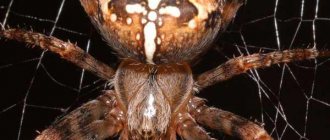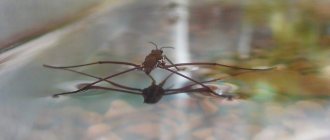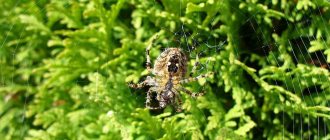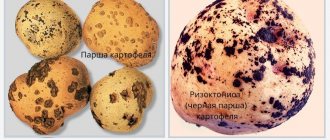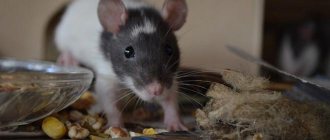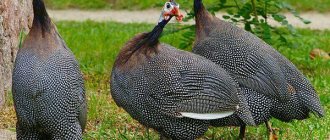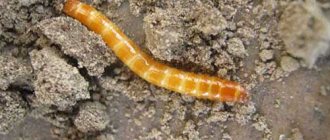Beetles are the most numerous group of insects. The number of existing species reaches 400 thousand. Among the representatives of the order Coleoptera there are many interesting specimens that cause surprise in appearance or behavior. The Hercules beetle is a recognized giant and strongman among its relatives. With a body length of up to 17 cm, it is the largest species of the Dynastes genus. The inhabitant of the tropics is completely safe, it feeds on ripe fruits.
Description of the species
The Hercules beetle (lat. Dynastes hercules) belongs to the lamellar family, genus Dynastes. Hollow beetles are the largest beetles, which are characterized by outgrowths on the head and pronotum of males. The head is small, the antennae consist of 10 segments, ending in a club. There are 300 rhinoceros beetles in this genus. Close relatives of Hercules include the scarab, elephant beetle, and rhinoceros beetle.
The body size of males is 125-145 mm, but sometimes reaches record levels of 171 mm, females are smaller - up to 80 mm. The body is black, covered with sparse red hairs. Like a typical representative of Coleoptera, its fore wings were transformed into solid elytra. In terms of strength, they are not inferior to the chitinous cover of the body. At rest, the elytra cover the mesonotum and the upper part of the abdomen.
Their color depends on the level of environmental humidity. The main color is olive, brown or yellow. It is complemented by black spots, the size and position of which can vary. There is a Hercules beetle with a bluish-gray or black elytra, such as in the photo. The adult can achieve a color change in just a few minutes. This amazing property of beetles has attracted the close attention of scientists. Rapidly reversible migrations of colored pigment in an insect's shell is a very rare ability.
The hind wings of insects have not atrophied; they can make short flights. The legs are long and have strong serrated claws that allow them to climb tree trunks. The fore tibia are digging, with their help the insect burrows into the leaf litter. When spread, the wingspan is 22 cm.
Interesting fact. Dynastes hercules amazes not only with its size, but also with its weight. How much does the Hercules beetle weigh? The weight of the imago reaches 110 g, the larvae - 100 g.
Sexual dimorphism
Males and females are noticeably different from each other. The male has a large black horn on his head, pointing forward. The end is curved upward and has several teeth on the surface. The second horn begins on the pronotum. Its length can exceed the size of the insect's body. The organ is also directed forward and curved downwards. Yellowish-brown hairs grow along the horn; there are two teeth on the front part.
Information. The size of the horns is an indicator of the male's physical health and nutritional quality.
The description of the female Hercules beetle differs significantly from the description of the male. Sometimes they are mistaken for beetles of different species. Females do not have horns. The color of the elytra is dark, the body is almost completely covered with red hairs. The size of the female individual is 70-80 mm, but they are inferior to males solely due to the lack of horns.
Interesting fact. The Hercules beetle was named for its extraordinary strength and endurance; it is believed that it can lift a load 800 times its weight. But this is just a myth; in fact, an insect with the name of an ancient Greek hero lifts up to 8 kg.
Beetle larva
The larva is large, C-shaped. The integument of the body is soft, sclerotized, covered with sparse hairs. At an early stage, the color of the body is white, but towards pupation it turns yellow. The head of the Hercules beetle larva is black and well developed. Its surface is textured and not smooth like other types. The body consists of 12 segments, the anus is in the form of a transverse slit. There are noticeable dark spiracles on the sides of the light body.
The mouthparts are gnawing type. The upper jaw is triangular in shape, with two massive teeth on the inner edge. The larva has three pairs of jointed thoracic legs. After 1.5-2 years of development, it turns into a free-type pupa.
What are some interesting facts?
There are several interesting facts associated with the beetle. The insect received its name in honor of the ancient Greek hero. The giant is known for being able to lift objects weighing 800 times heavier than the Hercules itself. Therefore, this beetle was often used as a kind of entertainment.
The insect was sent to fight with a scorpion. Most often it was Hercules who won.
Another interesting fact is that an insect can instantly change the color of its wing covers. This interested scientists from different parts of the world.
Some hobbyists breed insects in order to increase the population size. A pair of medium-sized beetles will cost $300-500. The price directly depends on the size, color and other characteristic features.
This video will show the stages of development of the Hercules beetle:
Habitat
Where does one of the largest insects, the Hercules beetle, live? Its homeland is South America. The giant can also be found in Central America. Habitat: Mexico, Bolivia, Colombia, Venezuela, Brazil, Ecuador, Panama, Peru. Some subspecies are found in the Lesser Antilles. Insects prefer moist tropical and subtropical forests with an abundance of greenery and fruits. Where does the Hercules beetle live? The forest floor serves as the giant's home. Adults hide at the base of trees, and larvae hide in rotting wood. The beetles are found in mountain and lowland forests during the wet season.
Lifestyle
The structure of a beetle is closely related to its lifestyle. Adults burrow into the litter, so they have an expanded anterior edge of the body and a powerful pronotum. Insects are active at night. They crawl under trees in search of fallen fruits and climb up the trunk onto branches. In search of food, the Hercules beetle flies from tree to tree. Its hind wings are membranous, transparent, and slightly olive-yellow. The flight occurs with the elytra open. In the air, a large beetle makes a loud buzzing sound.
The organ of smell for Hercules is the short antennae on the head, ending in a club. Before flying, the plastic organs open, the surface of the antennae increases, helping to better capture surrounding odors. The Hercules beetle is an insect with complete metamorphosis. This means that its life cycle includes four successive stages:
- egg;
- larva;
- chrysalis;
- imago.
Information about the Hercules beetle will be incomplete without talking about its enemies. The best defense against enemies is the appearance of a giant. Predatory insects do not fight with it. But, despite its impressive size, it also becomes prey for animals. In the tropical jungle where the beetle lives, it is hunted by rodents, reptiles, and omnivorous mammals. One of the main enemies is bats. Parasites in the form of mites and nematodes undermine the health of insects.
The helpless larva faces even more dangers. It is attacked by ants, ground beetles and predatory centipedes. The Scolia wasp is one of the most dangerous enemies of lamellar beetles. A large hymenoptera insect parasitizes larvae. With a well-aimed sting, the wasp paralyzes the victim and lays an egg on it. The born Scolia larva feeds on the body of the beetle larva without affecting the vital organs. White-bearded peccaries and boars do not deny themselves the pleasure of eating a protein delicacy made from a rotten stump.
Information. The Hercules beetle species has 13 subspecies, spread across the islands of the Caribbean Sea and South America. Their representatives differ slightly in the size of individuals and the color of the elytra.
The Amazing Abilities of the Strongman Beetle
As the largest beetle on the planet, the Hercules beetle also has dimensions to match its heroic name: its length from the end of the upper horn in front to the point of closure of the apexes of the elytra in the back can reach 171 mm.
Hercules beetle on a person's hand
Considering that the length of the Hercules beetle's horn is approximately half the total length of the body, its absolute length is approximately comparable only with the body dimensions of another giant - the Goliath beetle.
You can also read our article: Dung beetle, appearance and damage from insects
About the appearance of an insect
Dynastes hercules, belonging to the family of Lamellar beetles, is distinguished by its enormous muscular power: with the help of a thread tied to its body by researchers, it moved, dragging behind itself, a load of about 8 kg.
The appearance of the Hercules beetle is no less amazing. This is, first of all, a kind of vertical asymmetrical “claw” formed by two outgrowths of the body.
Hercules beetle head close up
Its lower half is made up of a horn on the head sticking forward and smoothly curving upward, having several serrated teeth and (often) a forked top.
The pronotum of the Hercules beetle continues into the longest beetle-specific outgrowth on Earth - a peak protruding forward, arching downwards. The number of notches on it (both downward and protruding to the sides) may vary.
Fight between two Dynastes hercules beetles
The lower edge of the thoracic outgrowth of the Hercules beetle is supplemented with a narrow brush of dense hairs, starting from its very tip in front and continuing to its very conical base in the back.
The body length (that is, the size of the Hercules beetle) is influenced, first of all, by the sex of the individual - the largest female beetles are always smaller than the smallest males.
The dimensions of the “male” Hercules beetles depend on many factors, including:
- the subspecies to which this specimen belongs;
- conditions in which its development took place.
The relationship to one or another subspecies also determines the color of the body, without which the description of the Hercules beetle would be incomplete.
In addition to the fact that female Hercules beetles do not have horns, they are “dressed” much more modestly - in yellow or brown-black tones.
Comparison of a male (left) and female (right) Hercules beetle
Males, on the other hand, sport the coloration of the elytra, the tone of which varies from bluish to yellow-gray with small speckles, and almost black (or purely black).
Insect nutrition
The question of body coloring is directly related to something else: what does the Hercules beetle eat, and what does the Hercules beetle feed on, and that one – with the habitat of the insect, which may have a “registration”:
- Mexican;
- Brazilian;
- Colombian;
- Ecuadorian;
- Caribbean
After all, the development of each subspecies of the Hercules beetle is associated with the wood and fruits of certain tree species common in a certain area, and this is already a topic of the specific composition of the soil under the roots of the tropical forest and the climate in it.
Hercules beetle on a bunch of bananas
Humidity is especially important in the climate, because adult beetles feed on fresh or already fermented juice of fruits, both slightly spoiled and obviously rotten.
Life cycle and reproduction of an insect
The level of air humidity in the wilds of the tropical forest is also important because the development of the Hercules beetle is impossible without rotting wood, which is necessary for feeding the insect at a certain phase of its development.
Reproduction process of the Hercules beetle
A fertilized female Hercules beetle lays eggs (up to 100 pieces) in cavities she finds in wood with a degree of decay suitable for uniform heating of the eggs.
And since the most suitable substrate for this purpose is rot in the hollows of trees, clutches of Hercules beetle eggs are most often placed there, hence the name of this genus of beetles - hollows (Dynastes).
The hatched Hercules beetle larva is initially capable of feeding only on the most delicate structures of rotten wood, but then masters increasingly coarser food.
Hercules beetle larva
Over the course of 1.5-2 years of its existence, the Hercules beetle larva reaches development sufficient for pupation: body length up to 180 mm with a maximum weight of 100 g.
The pupal stage requires relocation to the soil under a food tree and takes about 6 weeks, after which the young beetle hatches.
Dynastes hercules beetle pupa
Danger to humans
The question of why the Hercules beetle is dangerous can only evoke a smile, in which bitter irony is adjacent to regret about the indomitable ferocity of man directed against all living things.
After all, if even thick-skinned hippos and rhinoceroses, insane in anger, cannot resist the resourcefulness of his mind and technical power, how can the Hercules beetle protect its life?
No, despite the formidable appearance of the Hercules beetle, it is not capable of causing harm to humans. The beetle's mouthparts are not suitable for biting (much less biting) skin.
Method of holding a Hercules beetle
Even a child can freely pick up a beetle with his bare hands without any harm to himself.
Threat of extinction
Unfortunately, even the most careful maintenance at home and attempts to breed the Hercules beetle are not able to save the giant from the danger of extinction as a species.
Indeed, in addition to the short natural lifespan of the Hercules beetle (the entire life of an adult beetle lasts no more than six months), it has two enemies:
- collectors;
- merciless deforestation.
Despite the outward harmlessness of their occupation, collectors of rarities contributed to the creation of a real industry for the extraction of tropical beetles and butterflies.
Hercules beetle in frame
So, having barely acquired a specimen of a Hercules beetle with dark gray elytra, a greedy money-grubber already dreams of an individual with varnish-black ones - and a new detachment is sent into the jungle, which will take out not just one beetle, but as many as can be found.
The screech of chainsaws felling trees fills the rainforest day and night, and powerful tractor machinery completes the destruction. For all its apparent immortality, the jungle year after year retreats further and further from its original boundaries, saving the dwindling ecological heritage of humanity in its thinning thickets.
Conclusion
Who can stop the merciless torture of nature and the extermination along with it of more and more new animal and plant species? Only human.
A man who declares himself the crown of creation and declares that he sounds proud. And at the same time, he admits that sometimes he himself does not know what he is doing.
This excuse was suitable in times when he had to defend himself from predators with a club and a stone. But they are long in the past, and it is high time for man to recover from the intoxication of predatory feelings - and finally put his planet in order.
This can only be done through the joint efforts of peoples and governments. But in order to encourage the latter to take decisive steps, it is necessary for the broad masses to become aware of environmental problems, and this is impossible without education.
Unfortunately, the low standard of living of the tribes who hunt for forest curiosities and allow themselves to be robbed with impunity is also the result of the environmental policy of the world community.
But let both those who silently agree with it and those who dismiss it with annoyance, citing being busy, remember: the jungle is the “green lungs” of the Earth, and if they die, we will simply have nothing to breathe.
Video: Amazing insects (Hercules beetle)
Features of reproduction
The mating period of beetles occurs during the rainy season. In South America this time is from July to December. Peace-loving and phlegmatic males become implacable fighters when it comes to courting females. The beetle's two horns form a kind of pincers, with which they try to push through the elytra of the enemy. With a successful capture, the Hercules damages the chitinous cover of the opponent. The battle continues until one of the competitors falls on his back or retreats as a result of being wounded. A lethal outcome of the battle cannot be ruled out. Only the strongest will be able to continue their lineage.
Fertilized female Hercules beetles dig holes in rotten trunks with their paws, then lay eggs. The clutch can consist of up to 100 eggs with a diameter of 5 mm. This is a primitive manifestation of care for offspring. It hides from enemies and is provided with food. After 4-6 weeks, larvae appear in the food substrate.
The larvae have 3 instars:
- the first one takes on average 50 days;
- second - duration 50-55 days;
- the third is the longest stage, 400-450 days.
The third phase of development of the Hercules beetle is the pupa. In Coleoptera it is of a free or open type. Before pupation in the cradle, the larva grows to enormous sizes and gains impressive weight. Cases have been recorded when it weighed 120 g. Before pupation, the larva builds a special chamber in rotten wood, soil or litter. The cradle differs from the cocoon in material. For its production, natural elements are used, and not silk threads produced by the insect’s own glands. The larva forms an egg-shaped cavity, one of the walls of which is made of compressed soil.
If the larva is completely different from the imago, then the pupa has legs, the rudiments of organs, and the males have noticeable horns. The head is tucked under the chest. The body color is red-brown. It differs from other stages of development in its immobility. The pupa does not feed, its legs are motionless, bent at the knees. This phase consists of one age. The pupal stage lasts about 1 month. The insect will not be able to move until the adult develops under the cuticle of the pupa. Before the imago appears, the integument becomes darker. The birth takes place away from prying eyes. After the beetle emerges, its elytra are soft and light-colored.
During this period they are especially vulnerable. The young beetle needs time to carefully spread its thin wings and harden the elytra. The insect sits in the shelter until the elytra acquire a characteristic olive-yellow color and a safe density. The chitinous cover will acquire full hardness no earlier than after three weeks. At the age of one month, Hercules males begin fighting for the female and the possibility of procreation.
How long does the Hercules beetle live?
The insect's life cycle begins with the egg stage, which takes 4-6 weeks. Then the larva hatches. This is the longest stage; in favorable conditions (humidity about 70-80%, temperature +25°C, a lot of wood fibers) it lasts 1.5 years, but can last up to two years. The lifespan of an adult Hercules beetle is 3-6 months. In unfavorable conditions, the life cycle increases. If the male does not impregnate the female, he can live up to 12 months.
Interesting fact. The development time of the larvae depends on the sex - males grow 2-3 months longer than females.
Appearance and features
In terms of external qualities, the Hercules beetle is considered quite terrifying.
It has impressive weight, large dimensions, and black horns. The upper horn is large and serrated, the lower one is smaller. The large horn is slightly rounded and directed forward. The size of the upper horn will determine the size of the rhinoceros beetle itself. The size of an adult is directly dependent on the quantity and quality of nutrients consumed.
In this case, the nutrients supplied during the pupal and larval stages play a role. During development, one larva can reach a size of eleven centimeters.
The power of Hercules is highly valued among fans of animal fights. People often organize exhibition fights between scorpions, lobsters, and rhinoceros beetles. The latter often emerge victorious.
In addition to weight and dimensions, Hercules has other external features:
- beetles are divided into males and females. Females are always much smaller in size than males;
- Sexual differences are easy to determine not only by the size of the insect. The colors also give them away. Males have a black head, horns, and a set of forewings that can be brown or various shades of green. Females are always brown-black;
- According to recent discoveries, the Hercules beetle can change its color depending on its habitat. The color of the shell can be used to assess the level of humidity in the area.
Feeding of adults and larvae
Adult beetles feed on plant matter. The basis of the diet is juicy overripe fruits. Hercules will not refuse to enjoy the fermented juice. The beetle can feed on a large fruit for about a week until it sucks it completely. Beetle larvae are saprophages; they feed on rotting wood or a substrate of soil and plant remains. In the intestines of insects there are bacteria that process cellulose. At the first stage of development, the larvae eat soft fibers; as they mature, they move on to coarser food. They eat a lot and almost without a break.
Relationship with a person
Adults and larvae do not cause harm to agriculture. Because of the frightening appearance of the insect, the question arises: is the Hercules beetle dangerous for humans? Definitely not, he is a vegetarian, does not attack people, does not carry diseases, and is not poisonous. Lovers of exotic fauna keep giants at home and take their pets into their hands without fear. If you get to know the insect better, it turns out that it is beneficial. How is the Hercules beetle useful? Its larva is involved in the processing of organic matter, crushing it and passing it through the intestines. They belong to saproxylophagous insects that eat wood at the last stage of decomposition.
general information
Hercules is called that way because of its large size and power. Indeed, he can only be compared with Hercules, the hero of ancient Slavic myths. The largest among insects, surpassing in strength and weight almost all representatives of its species, the insect attracts the attention of many lovers of unusual representatives of the fauna.
The Hercules beetle looks (even in the picture) quite scary. If we consider a brief description, then:
- it has large horns on its head, which is why it is often called the rhinoceros beetle,
- on the back there are growths specific to insects of this species,
- The body length reaches 17 cm, and the weight of an adult beetle can be more than 100 g (thanks to this indicator, it is included in the Guinness Book of Records).
The beetle has been a great help to science thanks to its coloration. Scientists were able to identify special substances that change the color of the shell. These substances are produced to varying degrees depending on environmental conditions, and the color changes very quickly, which helps the insect survive in almost a wide variety of conditions.
Among the distinctive external features, one can also note the division of Hercules into males and females (and females are always smaller in size, unlike males). The sex of an individual can also be determined by its color - females have black-brown wings, while males, as a rule, have green wings. Rolled oats can acquire one color or another depending on its living conditions, or more precisely, the moisture content of the soil and air.
Keeping at home
In the 20th century, due to a decrease in the number of Hercules beetles, they began to be bred in insectariums. Keeping insects is accessible not only to entomological scientists, but also to simply lovers of exotic fauna. For a pair of beetles or a male and two females, you will need a container with minimum parameters of 50x50 cm, height 100 cm. A special substrate made of peat, wood, and oak leaves is poured onto the bottom.
Attention. All ingredients taken from the natural environment must be treated with high temperature, this will get rid of ticks and other parasites.
Several driftwood and pieces of bark are placed on the ground for beetles to climb. The optimal temperature for insectarium inhabitants is 20-25°C, humidity within 70%. No additional lighting required. Additional heat sources are not needed; they will dry out the air and food. Newbies to keeping tropical insects believe that rising temperatures will have a beneficial effect on their pets. But that's not true. At +28°C the larvae become lethargic and feed poorly. Heat can lead to their death. Maintaining the required level of humidity is not difficult; just spray the substrate daily with a spray bottle of water.
What does the Hercules beetle eat? In captivity, they do not have to be fed only tropical fruits. Adults eat soft, juicy apples, pears, peaches, grapes, and bananas. The fruits are placed in a feeder and replaced every day. Drosophila flies appear near the fruit, but they are not dangerous to the beetles. The larvae eat rotten wood and a mixture of fallen leaves, and it is recommended to give them dry dog food.
Reproduction of beetles in captivity
To breed insects, a 30-35 cm layer of substrate is poured into a container with a volume of at least 100 liters. It must contain rotten wood. Deciduous tree varieties are suitable - oak, birch, beech. The soil needs moderate moisture; it should not dry out or become waterlogged. Both conditions are harmful to eggs and larvae. It is believed that each larva will require 10-15 liters of substrate. It needs to be replaced when the layer is significantly reduced or there is a large amount of excrement (more than 50%).
Attention. Small larvae of the first instar can be kept in groups of 10, and individuals of the last instar should be placed in separate containers. Large larvae do not like competitors when sharing food and space.
Adult larvae require a large volume of compost. When changing material, it is recommended to leave part of the bedding. The old substrate is mixed with the new one. This will preserve the beneficial bacteria that have multiplied in the litter. Habitual crops will prevent upset of the larva's digestive system.
The end result of proper care for almost two months is a huge, fleshy larva. In some cases, the owners recorded a weight of 140 g. The larva is ready for pupation in the substrate. The pupa will be placed in a special cradle made of wood and plant particles. Before the young beetle emerges, the pupa shell becomes thinner and becomes paper-like. The young Hercules tears it apart and gradually frees himself. In the insectarium, it climbs onto a snag, where the elytra darken and harden.
Character and lifestyle
Hercules, like any other living creature, has its own lifestyle and character. So, he leads mainly a nightlife. During the day, the beetle prefers to hide under fallen leaves, and in the evening and at night it goes in search of food. The beetle does not crawl and fly very quickly due to its size, but it still spends most of its time actively. Sometimes he can climb a tree to drink some tree sap, he does this through cracks in the bark of young trees.
Hercules is a warlike beetle. Males often come together in a battle, the cause of which can be either a piece of food they like or a female they both love. The challenge to a kind of duel is carried out using a special stridulation apparatus. When beetles come together in battle, they go to the end, almost always the duel ends in the death of one of them. But it should be noted that the rhinoceros beetle is quite friendly towards humans; it is absolutely not dangerous to people. There are no recorded cases in history when Hercules attacked a person first.
It also does not harm garden crops and house plants, since it eats only a limited range of foods. People are not afraid to have a Hercules as a pet and periodically pick it up, since it does not bite or cause harm.
Why is the Hercules beetle disappearing?
Human economic activity leads to a reduction in natural habitats suitable for insects, as well as to air and water pollution. Massive deforestation of tropical forests is depriving beetles of a home and food. For the development of offspring, they need old tropical trees with rotten wood. Why is the Hercules beetle exterminated? There are several reasons why locals hunt giant insects:
- The large, fleshy larvae are used as food.
- Beetles and their horns are used in folk medicine. In South America they are considered a medicine that restores strength and health.
- This amazing insect has become a coveted object for numerous collectors. The rare beetle is expensive, so they are caught for sale.
An unreasonable attitude towards nature has led to the threat of extinction of the species. The Hercules beetle is listed in the IUCN Red List, and measures are being taken to restore the number of insects. The species is bred and studied in the insectariums of European zoos. In France, in the city of Besançon, there is a studbook of the Hercules beetle.
